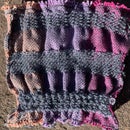Introduction: Weaving Multiple Layer Structures
The assignment for this weekly was to spend 2 hours on the loom while listening to music. The goal was to get comfortable with the loom and experiment with different structures. We had recently learned about multi-layered structures, so I wanted to challenge myself to weave a two-layer structure on this sample.
Supplies
rigid heddle loom (at least four shafts) https://schachtspindle.com/product/table-loom
yarn
scissors
Step 1: Starting With Tabby
I started by weaving a few rows of a tabby pattern to get a feel of the loom and to have a good start on my cloth. I noticed instantly that the loom was warped in two alternating colors, so when you lift up every other shaft for tabby it raises all white, and leaves the black.
Step 2: Drafting the Double Layer Pattern.
We learned in class that you can come up with multiple layered structures by looking at the cross-section of the warp and using it to make the draft pattern. Once I had the draft pattern, I used grid paper to find the lift plan. I opted for the two-layered tabby weave because it was the most simple and used the least amount of shafts.
Step 3: Weaving
We have the lift plan, we have a few inches of tabby, the only thing left to do now is weave! I noticed that the double-layered pattern took twice as long as the tabby because you're only using half of the warps per layer, the yarn can be packed much tighter. after a section of double layer, I experimented with different patterns by just experiment with lifting different shafts and finding the pattern that resulted. unfortunately, my adacad file didn't save so I don't have the draft plans for these sections.
Attachments
Step 4: Reflection
I really enjoyed weaving on a proper loom with shafts as opposed to the cricket looms we have been using so far in class. It was a fulfilling experience learning these double-layered patterns in class and seeing them actually come together on the loom. I can't wait to keep experimenting with different patters and possibly integrating electronics...














